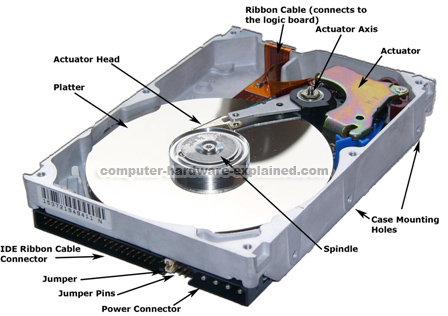Hard Drives


Sources:
1st Picture:http://www.pcguide.com/ref/hdd/
2nd Picture:
http://www.computer-hardware-explained.com/images/hard-drive-labeled.jpg
How
it works
A hard drive may look like a complex piece of hardware but the
way it saves data is a process that can be understood
intuitively with a little physics. When the hard drive is
supplied power, it causes a silver platter or silver platters to
spin via a motor driven spindle located in the middle of
the platter(s). The faster the spindle spins the platters, the
quicker the data can be read from the hard drive. Typically,
hard drives today spin at speeds of 7200rpm but some server hard
drives can reach speeds ranging from 10,000rpm - 15,000rpm. Basic Parts
- Silver Platter(s)
- Actuator
- Actuator Head
- Ribbon Cable
- Spindle
Writing Data
When a hard drive is instructed to write data, the actuator
moves out over the silver platter stack and positions the
actuator head precisely where it wishes to start writing data.
The head is a small electromagnet and to write data, it changes
the magnetic polarization on the platter which is translated to
the computer as binary ones and zeros. To read data, the
actuator once again moves to the location on the disk but rather
than changing the magnetic polarization it simply reads it. But
how does it do this?Reading Data
By using Faraday's Law, we know that the EMF generated is
directly proportional to the rate of change of magnetic flux.
Therefore, the head is reading whether or not data has been
changed by detecting voltage jumps from changes in the magnetic
polarization on the silver platter. Where the head detects a
voltage displacement (the voltage jump can be either positive or
negative) it record a binary one. Oppositely, when the head
records that no voltage displacement has occurred, it records a
binary zero. These binary values are then passed to the computer
for processing via the ribbon cable located on the underside of
the hard drive casing.Faraday's Law:
EMF is directly proportional to the rate of change of magnetic flux
As stated in the beginning of this section, a faster
spinning platter results in quicker data reading/writing. We
now know why this is the case, when the actuator head is
positioned above some location on the platter, it
manipulates the magnetic polarity of the platter or detects
voltage displacements in that specific location. These
processes can be accomplished almost instantaneously for any
given ring the actuator head reads from or writes to in one
disk rotation. Hence, by speeding up the disk rotation, the
actuator head can complete a full rotations worth of
reading/writing and move onto the next ring faster resulting
in faster data transfer.
Actuator Precision
In order for the electromagnet on the actuator
head to do anything with the magnetic polarization, it must
get incredibly close to the silver platter surface with
immaculate precision. This is once again achieved by using
the physics that govern electricity and magnetism. Inside
the actuator, the mechanism (a straight wire) that controls
its movement is placed in between two very powerful magnets.
When current is directed through the wire, the wire
experiences a Lorentz force.
What is a Lorentz force?
A Lorentz force is a force that is induced by
a current carrying wire placed in a magnetic field. In the
case of the hard drive actuator, when current is ran through
the wire in one direction, it causes the actuator to
experience a Lorentz force and move towards one of the
powerful magnets. On the other hand, running a current in
the opposite direction generates a Lorentz force that moves
the actuator in the opposite direction. The current that is
ran through the wire can be controlled with extreme
precision and as a result, the actuator can also be
controlled with similar precision. Therefore by use of
Lorentz forces, hard drives can read and write data with up
to 10nm of precision.
Lorentz Force Equation

The force experienced by a current carrying wire within a
magnetic field is in the direction of the cross product IxB
source: Lorentz Force: http://hyperphysics.phy-astr.gsu.edu/hbase/magnetic/magfor.html
